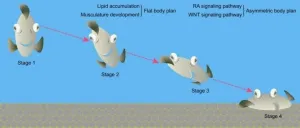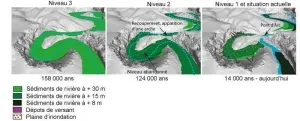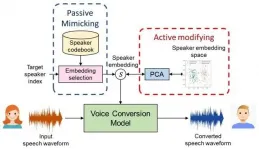(Press-News.org) Narcolepsy with cataplexy, or narcolepsy type 1 (NT1), is a rare and chronic neurological disease whose prevalence increased in children and adolescents after the administration of Pandemrix swine flu vaccine in 2009-2010. It is an autoimmune disease to which a specific inherited tissue type (HLA-DQB1*0602) predisposes people.
The disease mechanism of NT1 was investigated in a collaborative study carried out by PhD student Arja Vuorela and university researcher Dr. Tobias Freitag, working in the research groups of Prof. Outi Vaarala and Prof. Seppo Meri. The study analyzed the cell-mediated immune response targeting three different proteins of influenza A (H1N1) virus included in the Pandemrix vaccine, in Finnish children and adolescents who developed narcolepsy after Pandemrix vaccination.
The study was published in the journal Nature Communications.
Immune cells are activated by the body's own proteins in narcolepsy patients
The researchers found that immune cells in the blood of narcolepsy patients mounted stronger responses against two peptides originating from swine flu virus neuraminidase or nucleoprotein, compared to the cells of vaccinated control subjects.
By investigating similarities between the two identified viral peptides and human proteins, the researchers identified similar sequences in two self proteins present in the human brain. This led them to study immune responses in narcolepsy patients also to these self proteins.
What they found demonstrated that patient lymphocytes recognised a fragment derived from the human protein-O-mannosyl-transferase 1 enzyme (POMT1). This POMT1 peptide mimics the peptide from influenza A (H1N1) neuraminidase, that is a target of the immune response generated by Pandemrix vaccine.
"Interestingly, immune cells in patient blood produced the same mediators of inflammation as a response to the peptides of both viral neuraminidase or human POMT1 enzymes. Both peptides also brought about the development and selection of identical or similar T lymphocyte clones," says University Researcher Tobias Freitag.
Onset of autoimmune diseases likely explained by cross-reactivity
Prior research has uncovered that "molecular mimicry", the similarity between proteins produced by pathogens or expressed in human tissues, may trigger the development of autoimmune diseases in people genetically at risk.
According to the latest study, lymphocytes which recognise the virus cross-react with human brain tissue and, consequently, contribute to the development of NT1. Autoantibodies recognizing the human POMT1 enzyme were also found at higher levels in individuals vaccinated with Pandemrix.
"The results indicate that the Pandemrix vaccine triggered an autoimmune response in genetically predisposed people. All of the individuals who developed narcolepsy had the same HLA-DQB1*0602 tissue type, which predisposes people to the disease. Most likely, the effective adjuvant included in the vaccine also contributed to the autoimmune response," says Professor of Immunology Seppo Meri from the University of Helsinki. NT1 is a multifactorial disease.
The findings can boost further research aimed at the improvement of diagnostics and treatments for NT1, including therapeutic strategies modifying or redirecting the immune system.
"The findings of this study serve as a reminder that no medical procedure, including vaccination, is entirely without risk. As with all clinical decision making, vaccination recommendations need to consider both benefits and possible adverse effects. When new vaccines are introduced, especially those based on novel adjuvants or vaccine technologies, recommendations need to be tailored to different age and risk groups" Freitag points out.
INFORMATION:
The study was carried out by the NARPANord research consortium headed by Professor Markku Partinen from the University of Helsinki.
The colonization of the seafloor is one of the most important events in evolutionary history, leading to an explosive radiation and large-scale morphological diversification of marine phyla. Flatfishes are one of the most successful groups of seafloor colonizers and have evolved the most specialized body plan (i.e., flat and asymmetrical) among the teleosts. However, the origin and formation mechanism of the peculiar morphology of flatfishes had long been unclear.
Now, researchers from the Kunming Institute of Zoology of the Chinese Academy of Sciences ...
Announcing a new article publication for BIO Integration journal. In this mini review article the authors Meiyu Qiu and Pei Li from Korea Advanced Institute of Science and Technology (KAIST), Daejeon, Republic of Korea summarize CRISPR/Cas-based Diagnostics and Gene Therapy.
Clustered regularly interspaced short palindromic repeats (CRISPR) technology, an easy, rapid, cost-effective, and precise gene-editing technique, has revolutionized diagnostics and gene therapy. Fast and accurate diagnosis of diseases is essential for point-of-care-testing (POCT) and specialized medical institutes. The CRISPR-associated (Cas) proteins system shed light on the new diagnostics methods at point-of-care (POC) owning to its advantages. In addition, CRISPR/Cas-based gene-editing ...
People's ability to perceive speech sounds has been deeply studied, specially during someone's first year of life, but what happens during the first hours after birth? Are babies born with innate abilities to perceive speech sounds, or do neural encoding processes need to age for some time?
Researchers from the Institute of Neurosciences of the University of Barcelona (UBNeuro) and the Sant Joan de Déu Research Institute (IRSJD) have created a new methodology to try to answer this basic question on human development.
The results, published in the Nature's open-access journal Scientific Reports, ...
Not all stars shine brightly all the time. Some have a brightness that changes rhythmically due to cyclical phenomena like passing planets or the tug of other stars. Others show a slow change in this periodicity over time that can be difficult to discern or capture mathematically. KAUST's Soumya Das and Marc Genton have now developed a method to bring this evolving periodicity within the framework of mathematically "cyclostationary" processes.
"It can be difficult to explain the variations of the brightness of variable stars unless they follow a regular pattern over time," says Das. "In this study we created methods that can explain the evolution of the brightness of a variable star, even if it ...
Per- and polyfluoroalkyl substances (PFAS) in ski wax have been receiving a lot of attention recently, but waxes constitute only a limited part of the problem of the PFAS group of toxicants.
PFAS are a large group of man-made fluorocarbon toxicants, and you are most likely full of them. The toxic substances don't break down and instead accumulate, both in nature and in your body.
"Due to their extensive use, humans and animals all over the world are continuously exposed to PFAS," says Håkon Austad Langberg, a PhD candidate at the Norwegian University of Science and Technology (NTNU) who has studied several of them in the last few years.
PFAS are used in many different products beyond the fluorinated ski wax that ends up in the ground on ski slopes and on trails, ...
The corona pandemic has made us all focus on new ways of organizing our work. More and more companies and organizations around the world are considering how to meet their employees' demand for flexibility while at the same time reducing their office space and expensive rents.
There are advantages and disadvantages to working from home, and many factors that affect the peoples' experience of it, such as their job function, age and seniority, whether they have children, whether they are a manager or employee, etc.
Researchers from DTU Management have identified six main areas that company managers should focus on when developing strategies for remote work in future.
Associate Professor at DTU Management Christine ...
People who take a commonly-prescribed drug for inflammatory bowel disease (IBD) should not assume they are protected after a first dose of COVID-19 vaccine, after a large-scale study found many had poor antibody responses.
The research measured antibody responses after vaccination with the Pfizer/BioNTech or the Oxford/AstraZeneca COVID-19 vaccine in 865 people treated with infliximab, an anti-tumour necrosis factor (anti-TNF) biologic drug, prescribed to around two million people worldwide. Anti-TNF drugs are effective treatments for immune-mediated inflammatory ...
The Chauvet Cave, which lies by the entrance to the Gorges of the Ardèche, is home to the world's oldest cave paintings, dating back 36,000 years. Their state of preservation and aesthetic qualities earned them a spot on the World Heritage List in 2014, 20 years after their discovery. The location of the cavern--surrounded by a remarkable landscape, next to the Pont d'Arc natural archway--raises the question of whether the people who executed these artworks looked and walked out upon the same landscape as today. Did they see the same natural archway? Scientists from the CNRS, Université Savoie Mont Blanc, and the Muséum National d'Histoire Naturelle1 ...
Researchers from Skoltech (Russia) and their colleagues from SINTEF (Norway) have developed a mathematical model of freezing water droplets moving in cold air. This model is a part of a joint RFBR-supported Russian-Norway research project. The project is focused on predicting ice accretion on ships and other offshore structures operated in Arctic climate, which may interfere with their proper functioning and endanger crew members and cargo. The paper was published in the journal Energies.
Ships travel in cold northern waters under constant bombardment by tiny water droplets populating the chilly air. ...
Ishikawa, Japan - Robots today have come a long way from their early inception as insentient beings meant primarily for mechanical assistance to humans. Today, they can assist us intellectually and even emotionally, getting ever better at mimicking conscious humans. An integral part of this ability is the use of speech to communicate with the user (smart assistants such as Google Home and Amazon Echo are notable examples). Despite these remarkable developments, they still do not sound very "human".
This is where voice conversion (VC) comes in. A technology used to ...




